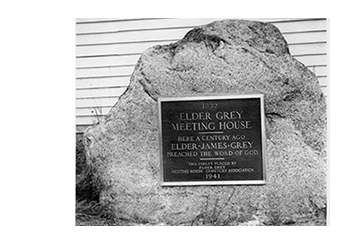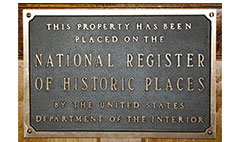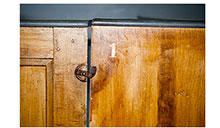

Meeting House History (con't)
There followed another period of inactivity until the early 1920s when interest in repairing the Meeting House was again sparked. The first annual pilgrimage service, attended by friends and family descendants from afar, was held in 1926. The Elder Grey Meeting House-Cemetery Association was formed in 1928 by founding officers Fanny Mills McDaniel, Maria Grey Kimball, Mary Mellen Sinkinson, Ella Libby Bradeen, Ethel Sinclair Downs, Mary Strout Goul, Herbert A. Bradeen, Harry S. Chadbourne, Ansel S. Davis, and Annie Chadbourne Sinclair. The Association has been active over the years keeping the Meeting House in good repair and the cemetery well groomed.
In 1941 Gray descendants John Sinkinson and Charles Stedman Grey unveiled a bronze plaque. Inscribed with these words:

1832
Elder Grey Meeting House
Here a century ago
Elder James Grey
Preached the Word of God.
This tablet placed by
Elder Grey
Meeting House Cemetery Association
1941
Also in 1941 Raymond H. Bradeen presented to the Association a deed for the land and building signed by Ralph and Mabel Emery. Although the church had been on the site since 1832, the Association had no legal title to the land until this deed was executed.
 Through the efforts of Evelyn Thompson and the Waterborough Historical Society, the Meeting House was placed on the National Register of Historic Places on October 9, 1979. It was deemed an historic place worthy of preservation and was the first building in Waterborough to be so designated.
Through the efforts of Evelyn Thompson and the Waterborough Historical Society, the Meeting House was placed on the National Register of Historic Places on October 9, 1979. It was deemed an historic place worthy of preservation and was the first building in Waterborough to be so designated.
The Elder Grey Cemetery is situated across the road, guarded in the front by a rugged stone wall built in 1938 by Erving Stuart. For expansion, Willis Lord and his sister Edith Pierce have donated additional land. 
And best you not be tardy. The pulpit and two front doors face the congregation, so the disapproving looks of your fellow churchgoers as you enter and proceed up the sloping floor, facing all, could be embarrassing.
Affixed to eight of the pews are name plates. Although the records do not reveal their history, a best guess is that descendants paid for their placement, perhaps on the pews they believed their ancestors had traditionally occupied. The names on the plates are James C. Chadbourne, Jacob Bradeen, James M. Chadbourne, Col. Ivory Parcher, William Mills, James Mills, Edmund Webber, and James F. Lord.
 A careful observer will note a patch in the ceiling, the only evidence of the stove that at one time heated the building. An old pump organ, purchased by the Association within the last fifty years, is at the back of the church. Its straps fairly regularly provide nesting material for mice during winter months. But on the first Sunday of every August, the organ can regularly be heard leading the congregation as they sing at the annual Pilgrimage Service. Read about the 2016 Service here.
A careful observer will note a patch in the ceiling, the only evidence of the stove that at one time heated the building. An old pump organ, purchased by the Association within the last fifty years, is at the back of the church. Its straps fairly regularly provide nesting material for mice during winter months. But on the first Sunday of every August, the organ can regularly be heard leading the congregation as they sing at the annual Pilgrimage Service. Read about the 2016 Service here.
The 1806 Meeting House is a treasure to many, and its preservation remains a priority. Donations to ongoing preservation efforts will always be much appreciated. Learn how to donate by check or through our secure online PayPal gateway.